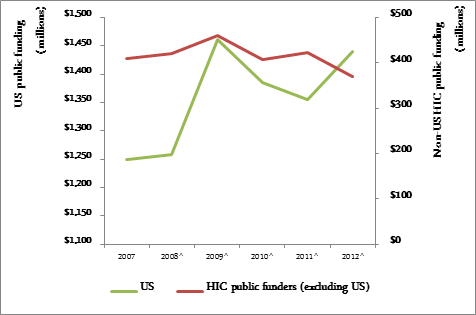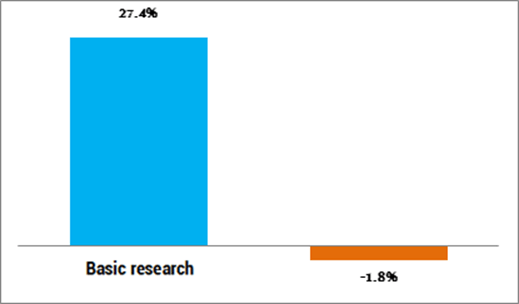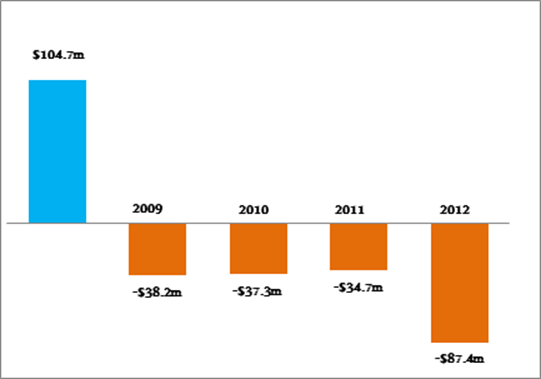In this guest post, Dr. Mary Moran—executive director—and Dr. Penny Farrell—analyst—from Policy Cures shares key findings from the recently released G-FINDER survey.
Nine million people still die each year from infectious diseases with lacking or insufficient treatments. The need for research and development (R&D)
for new products has never been more urgent. But R&D costs money. The annual G-FINDER survey collects data about funding for neglected disease
R&D from over two hundred organizations, including all major public, private, and philanthropic funders.
The 2013 G-FINDER report shows that overall funding for neglected disease R&D was $3.2 billion, about half a billion dollars higher than in 2007,
with the public sector providing two-thirds of this funding—around $2 billion. But beware—beneath this calm surface figure, there are
some dangerous currents, and their direction is changing rapidly.
1. New trends in public funding revealed
The headline public finding figure of around $2 billion has been maintained in 2012, but this figure masks marked new funding trends…

- Public funding for neglected disease R&D with and without the US. Click to enlarge chart.
If we focus on the 2011-2012 section of this graph, it’s clear that US funding is rising, but non-US funding has ebbed. In other words, US funding
is keeping neglected disease R&D afloat. In 2012, US funding increased by $86 million (up 6.4 percent)—the first increase seen by the
US government since 2009. US investment has almost returned to its 2009 peak, when there was a large infusion of funds under the American Recovery
and Reinvestment Act, created in response to the global financial crisis (GFC).
But between 2009 and 2012, non-US high-income country government funding has decreased by 20 percent. That’s over $90 million lost. Some of this is
cyclical. For example the United Kingdom’s Department for International Development disburses funds in generous 3-5 year cycles. But this does
not explain all of this worrying trend, and without the United States, public funding for neglected disease R&D would be spiraling downwards.
2. Public funding for R&D needs to change tack

- 2007-2012 percent change in funding to basic research and product development. Click to enlarge graph.
Another dangerous funding current is the post-GFC shift away from product development. Saving lives means not only doing basic laboratory research,
but also ensuring that this research is translated into new medicines, vaccines, and tests that will save many of the 9 million lives lost each
year to neglected diseases. But, post the GFC, governments have been redirecting their funding away from product development, which is often done
abroad, in order to support basic research that can be done, and funded, in academic institutes at home.
In the six years prior to 2012, there was a 27 percent increase in public sector funding for traditional basic research, but public funding for urgently
needed product development over the same period shrank by nearly 2 percent. For diseases that mainly rely on public funding, such as HIV and AIDS,
the result is a skewing of investment away from product development.
3. Funding for product development partnerships (PDPs) took its biggest blow yet in 2012

- PDP funding 2007-2012. Click to enlarge graph.
PDPs are a not-for-profit funding model that started around the year 2000. PDPs bring public and private organizations together to make products for
diseases where there’s a market failure. To date, they have been the most productive product development sector—we have them to thank for
nearly three quarters of the 18 new drugs and vaccines created for neglected diseases since 2000.
In 2009, PDPs received $530 million—but since then their funding has plummeted by nearly one-third, and 2012 saw the biggest decrease yet. In
early 2012, PDPs had at least 91 products for neglected diseases in clinical development. If this funding pattern continues, we will be forced
to ask which projects to drop—will it be one working on more reliable treatments for tuberculosis, one developing a cure for African sleeping
sickness, or one making a vaccine for malaria?
The 6th annual G-FINDER report was launched in London on Dec. 11, 2013, and is available at http://policycures.org/gfinder.html. Conducted by Policy Cures and funded by the Bill & Melinda Gates Foundation, G-FINDER reports on global funding of R&D for new products for neglected diseases.



